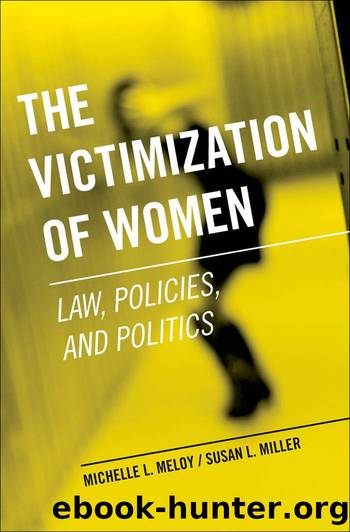The Victimization of Women by Michelle L. Meloy;Susan L. Miller; & Susan L. Miller

Author:Michelle L. Meloy;Susan L. Miller; & Susan L. Miller
Language: eng
Format: epub
Publisher: OUP Premium
Published: 2011-01-15T00:00:00+00:00
Battering and Public Housing
Domestic violence is cited as the primary cause of homelessness in many cities because victims who leave their abusers often have nowhere to go.32 In addition, in violent relationships, the abusers typically control the household finances as one method of manipulating victims into powerless positions, leaving battered women with no means of securing first and last monthâs rent or security deposits if they do choose to flee. Isolation from friends and family members is a common abuser ploy as well, so that when victims are alienated and estranged from people who could help themâor friends and family are threatened by the abuserâs violenceâthey have nowhere to turn.33
Following the nationâs general âwar on crimeâ policies, enforcement and prosecution agencies now use âthree strikesâ or âone strikeâ laws, instituted by state legislatures, to better combat repeat offenders.34 These draconian laws were designed to end perceptions of âsoftnessâ in sentencing and to deter potential criminals by advertising the severe consequences of crime commission. For example, âone strikeâ laws against criminals residing in or visiting public housing aim to crack down on government assistance to citizens deemed undeserving. However, such laws create a new group of victims by permitting evictions of any resident or visitor engaged in criminal activity. Of the over 5 million people living in public housing in the United States, most are minorities, and most of the households are female-headed. In 2002, the U.S. Supreme Court upheld a federal housing law, the Anti-Drug Abuse Act of 1988 (revised 1994), designed to evict public housing tenants for any resident or guest arrested for drug-related or violent crimes.35 This law unintentionally puts battered women at risk of losing their homes if they call police to report violence, essentially holding battered women responsible for their partnerâs abuse. Ironically, if they do not report the violence, they risk more beatings but can remain in public housing.36
The real-life implications of the Supreme Court decision were salient for Aaronica Warren, mother of an infant son, who lived in public housing in Ypsilanti, Michigan. Aaronicaâs ex-boyfriend beat her badly, yet she found the courage to call the police. About a week after reporting the battery, Aaronica received an eviction notice under this housing law. Even though the law was aimed at rooting out drug-related violence in federal housing projects, housing officials can evict any resident or visitor âwho has been convicted of a felony that occurred there or nearby, as well as others who live in the household.â37 Aaronicaâs quagmire stems from the case Department of Housing and Urban Development (HUD) v. Rucker, which challenged the eviction of 63-year-old Pearlie Rucker, a great-grandmother who lived in public housing in Oakland, California. Pearlie, her mentally disabled daughter, two grandchildren, and one great-grandchild faced eviction because the daughter was found in possession of illegal drugs three blocks from Pearlieâs apartment.38
The Rucker ruling is dangerous for battered women who are tenants in public housing, trapped in an abusive household with few options and no control over their violent partner or ex-partner.
Download
This site does not store any files on its server. We only index and link to content provided by other sites. Please contact the content providers to delete copyright contents if any and email us, we'll remove relevant links or contents immediately.
The Secret History by Donna Tartt(18070)
The Social Justice Warrior Handbook by Lisa De Pasquale(11938)
Thirteen Reasons Why by Jay Asher(8411)
This Is How You Lose Her by Junot Diaz(6407)
Weapons of Math Destruction by Cathy O'Neil(5795)
Zero to One by Peter Thiel(5453)
Beartown by Fredrik Backman(5301)
The Myth of the Strong Leader by Archie Brown(5212)
The Fire Next Time by James Baldwin(4996)
How Democracies Die by Steven Levitsky & Daniel Ziblatt(4940)
Promise Me, Dad by Joe Biden(4897)
Stone's Rules by Roger Stone(4827)
100 Deadly Skills by Clint Emerson(4658)
Rise and Kill First by Ronen Bergman(4534)
A Higher Loyalty: Truth, Lies, and Leadership by James Comey(4529)
The David Icke Guide to the Global Conspiracy (and how to end it) by David Icke(4358)
Secrecy World by Jake Bernstein(4352)
The Farm by Tom Rob Smith(4300)
The Doomsday Machine by Daniel Ellsberg(4228)
